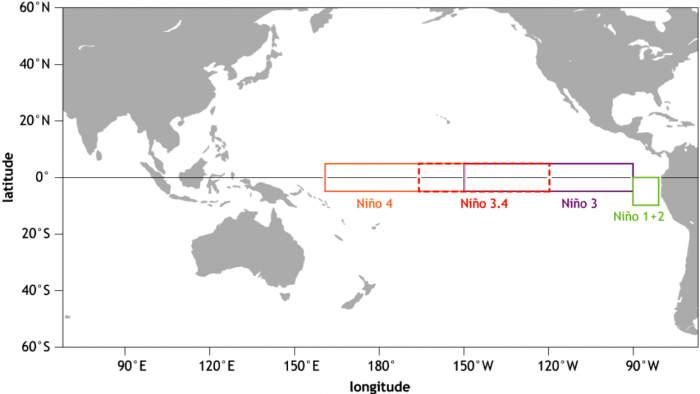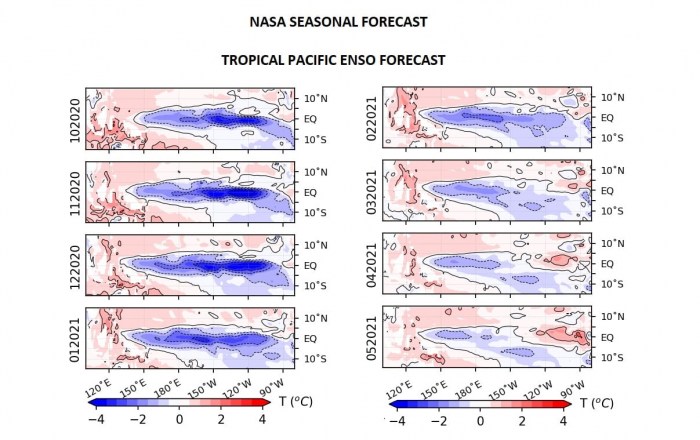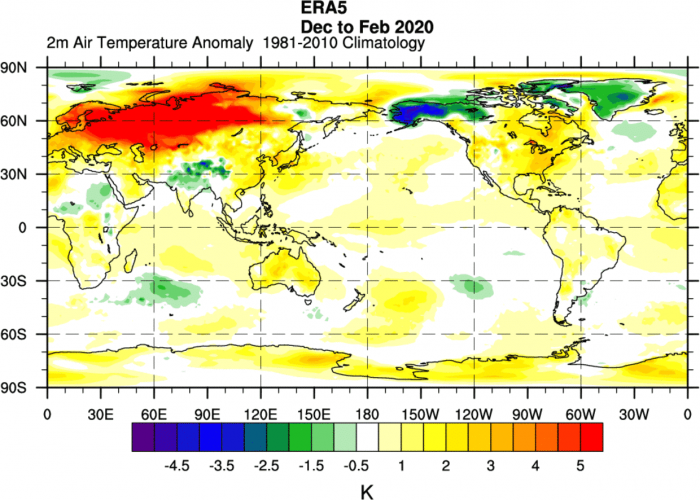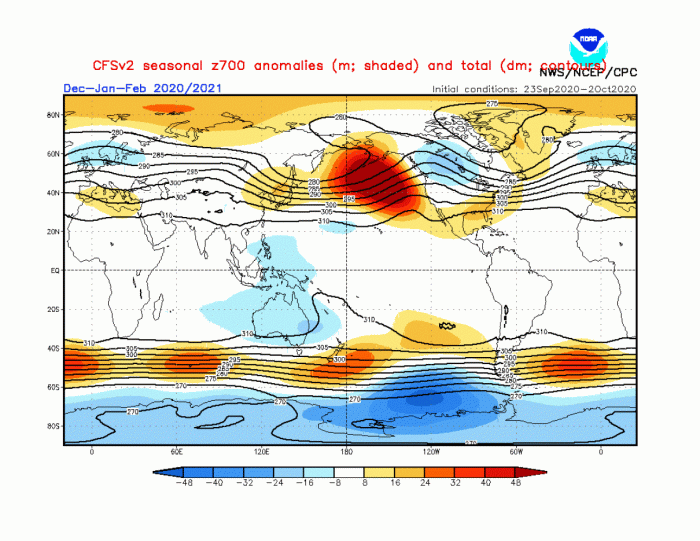The Winter season 2020/2021 will be under the spell of a strong La Nina cycle, emerging in the tropical Pacific ocean. It will alter the jet stream patterns over North America and the Pacific Ocean, extending its reach to the rest of the world. The Winter forecast from major models, reveals this jet stream altering by the La Nina, and its possible weather outcomes.
******
Don’t miss: THE LATEST UPDATED WINTER FORECAST 2020/2021 (November 2020 update)
******
To try and understand the Winter season and its forecast, one must know that there is no “magic bullet” when it comes to weather. The global weather system is a very complex system, a perfect live simulation of the chaos theory, with many large-scale and small-scale climate drivers. We will look at one of the more powerful drivers this year, and how it can/will influence the winter weather.
OUT OF THE OCEAN, INTO THE ATMOSPHERE
The development of a cold ENSO phase is the key-feature in weather evolution for at least the next 6 months. We have already discussed the impact of this negative ENSO phase back in May, with a lot of info on what exactly the ENSO is, and how it impacts weather around the world.
But to keep it simple, ENSO is short for “El Niño Southern Oscillation”. This is a region of ocean in the tropical Pacific, which alternates between cold and warm phases. The tropical trade winds (the easterly winds that circle the Earth near the equator) usually initiate or stop a certain phase, as they mix the ocean surface and alter the ocean currents.
ENSO has a major impact on the tropical convection patterns and the complex interaction of the ocean-atmosphere system, through which the ENSO influence is distributed globally. We usually observe a global scale shift in pressure patterns during the emergence of the ENSO phases, each having a unique impact on the weather.
The image below shows all the ENSO regions. The main regions are 3 and 4 and cover a large part of the tropical Pacific. Most calculations and diagnosis is based on a combination of both the 3 and 4 areas, which is why we call the main region “ENSO 3.4” or “NINO 3.4”.
Each ENSO phase has a different influence on the tropical weather and circulation and thus impacting the weather worldwide differently. A specific phase (warm/cold) usually develops around late summer and autumn, and can last until next summer, or even up to two years!
The cold ENSO phase is called La Nina and the warm phase is called El Nino. The ENSO phase is determined by the temperature anomalies (warmer/colder) in the ENSO 3.4 region in the tropical Pacific, we showed above.
Current analysis shows the ocean temperature anomalies and the now quite extensive colder-than-normal area in the tropical pacific. That is where La Nina emerged out of the ocean, and into the atmosphere.
Just 2 months earlier, La Nina was less impressive and was just starting to emerge in the core region. The image below shows the ocean analysis from the beginning of August.
The image below is an analysis and forecast by BoM Australia, which shows the evolution of the ENSO 3.4 region. We can see the main cooling began in Summer and should continue all the way into winter. The La Nina phase will reach quite a formidable strength at its peak but is expected to start to weaken towards spring 2021.
The forecast evolution from NASA indicates a similar pattern. It shows the temperature anomalies in the ENSO region, with the coldest phase in November and December.
The best way to depict an emergence of a La Nina is with a high-resolution animation over time. The video below shows the large scale cooling in the tropical Pacific Ocean, as the La Nina emerged from below the surface. It nicely shows the westward movement of the ocean surface, as the easterly trade winds strengthen, bringing La Nina to the surface.
THE WINTER JET STREAM OF LA NINA
The jet stream is a large and powerful stream of air (wind) at around 8-11km (5-7mi) altitude. It flows west-to-east around the entire hemisphere, affecting pressure systems, and their strength, thus shaping our weather at the surface.
Below is an example of the west to east flow during the last winter of 2019/2020. Yellow-red areas show stronger westerly flow (the jet stream) at the 250mb level (~10.5km / 6.5mi). We can see that the strongest jet stream was positioned over the North Atlantic, extending directly over the British Isles and into Scandinavia. The Pacific part of the jet stream was weaker and confined more to the ocean.
Looking at the pressure pattern during the last winter, we can see the strong low-pressure systems in the North Atlantic, following the path of the Jet Stream. It has brought very mild and stormy conditions to the British Isles and Scandinavia, while the rest of Europe was mostly drier and warmer, with a lower number of cold fronts. The winter was also mostly mild over much of North America, with a lack of intense persistent low-pressure systems further south.
Historically, the most typical effect of a La Nina is a strong blocking high-pressure system in the North Pacific. The image below shows the average pattern during the last few La Nina winters. We can see the strong high-pressure system in the North Pacific.
The circulation of the strong high-pressure system promotes the development of a low-pressure region over Alaska and Canada, bending the jet stream in-between the two pressure systems. A similar situation to what we have seen last year over the North Atlantic.
The image below shows the average position of the jet stream during La Nina years and the corresponding weather regions over North America. The bent jet stream brings colder air and storms down from the north into northern and the northwestern United States, and warmer and drier weather to the southern parts.
The jet stream over the United States can actually divide the country into 2 weather poles. The images below show the temperature and precipitation analysis during the past La Nina winters over the United States. The northern part of the country is hit more frequently by the colder and wetter events, as the jet stream directions the storm systems that way. But that can somewhat lockout the southern United States, creating warmer and quite drier conditions with less frequent storms and cold fronts.
The shifted jet stream also means a different snowfall potential. The colder air is more easily accessible to the northern United States, which also shows to have an increased snowfall potential during La Nina years. Especially areas like Alaska, Canada, and the northwest United States benefit from the northerly jet stream to produce more snowfall. The graphic is by NOAA-Climate.
After passing Canada and the United States, the jet stream moves out into the Atlantic. There are different pathways that it can take. A lot depends on the Arctic Oscillation pattern and the existing pressure systems in the Atlantic. This is where La Nina perhaps loses its direct influence, as regional systems in the Atlantic take over. But it usually still has an influence, as it changes the position of the entering jet stream from the west. The incoming jet stream can merge with the systems in the Atlantic, thus helping to create a whole new weather pattern for Europe. The problem is that the final outcome is far more unpredictable in the Euro-Atlantic zone, than over North America, which is under a more direct influence.
WINTER SEASON 2020/2021 MODEL FORECAST
We now know what La Nina is, and how it impacts the jet stream. Now we will take a look at the global long-range models, and how they see the developing La Nina Winter.
We decided to focus on the 3 main (or most used) seasonal models. The ECMWF and UKMO from Europe, and the CFSv2 from the United States. Graphics are from the Copernicus Climate EU project and the CPC/NCEP.
All these forecasts are an average picture over the course of 3 months (December-January-February) and show the general prevailing weather patterns. Even if the models would be completely accurate, it does not mean that such weather conditions would last for 3 months straight. It only shows/implies how the weather patterns might look 40-60% of the time.
The ECMWF model is most often referred to as the most reliable model, at least in the long-range category. In reality, a lot depends on the individual situation and individual seasons. But generally, the ECMWF model is at the top of the chart as far as reliability goes. But no long-range/seasonal forecast can ever be deemed “reliable”. We are only looking at trends and how the weather patterns might evolve over the entire continents or the planet.
In the pressure pattern forecast from ECMWF, we can see the strong high-pressure system in the North Pacific, typical of a La Nina. The low-pressure system is developed over Canada and the jet stream is bending in between, just like we have seen in the previous segment. We also see the North Atlantic in a positive NAO mode, which means an amplified jet stream over the British Isles and Scandinavia. But this is not a typical positive NAO setup, and it can be broken in-between. Most likely if the high-pressure system in the central Atlantic can crawl further up north, blocking the flow and creating a more northerly flow into Europe.
The temperature forecast below shows much of North America in above-normal temperatures. But this might not be the best solution, also considering what the model showed on the previous image with the pressure systems. Alaska and Western Canada will be colder than normal, with a high chance of the colder air extending towards the parts of the northern United States and also with a few storms into the northeast.
Europe also features higher than normal temperatures, but not to a high value. Tho a more westerly dominant scenario is likely, the pressure pattern does allow for a break in the flow, and occasional cold flow from the north into Europe, dependant on the positioning of the Atlantic high-pressure system.
Precipitation anomaly forecast shows a more normal La Nina type pattern over Canada and the United States. We see the mainland United States divided into 2 poles, with wetter conditions in the northern parts under the jet stream and drier conditions in the south.
Europe is totally neutral when it comes to precipitation. This is another indicator that the westerly flow situation is not particularly strong. This shows higher pattern diversity is likely, especially on a month-to-month basis.
Our second model of choice is the UKMO model, from the United Kingdom Met-Office. This has also been a good performer last winter, so we include it in our standard “suite” of model forecasts.
UKMO has a much more aggressive pattern than the ECMWF, and quite honestly, seems less likely at the current point in time. It shows the strong La Nina blocking high-pressure in the Pacific. But the main low-pressure area is centered over eastern Canada and Greenland. This causes a jet stream extension from North America directly into northern Europe. This means a quite milder winter for Europe, and also entire southern and eastern United States.
This time, the temperature forecast corresponds to the pressure pattern forecast. Much of North America is warmer than normal, especially the southern and eastern United States. But western Canada and the northwest United States would be colder than normal in this scenario.
Europe now features much warmer winter, and a lesser chance of breaking the pattern with occasional cold air outbreaks, as this pattern is more stable. This is not to say that there will be no cold air outbreaks, just that they are less frequent.
The precipitation forecast also nicely shows the “dipole” pattern over the United States, with drier in the south and wetter in the northern parts and with a higher chance of more snowfall, under the jet stream. Europe is again neutral, with hints of higher precipitation over Scandinavia, due to the higher frequency of storms moving over this area.
As a counterbalance, we decided to always use the main North American long-range model, the CFS version 2 model from the NOAA/NCEP in the United States.
The CFS model is a bit different than the other two European models. It has a beautiful classical La Nina pattern, with the strong high-pressure system in the Pacific and the Low-pressure system over western Canada. We can actually see a ridge building over the western North Atlantic. This is the situation we have mentioned before. This pushes the low-pressure area further into northern Europe. This increases the likelihood of colder northerly flow into northwest and central Europe.
We now see a more typical La Nina-like temperature pattern over North America, with colder air in Canada and warmer air in the southern United States. Europe is seen warm, but the pattern does allow colder air flows into the continent. The warmer anomaly means that the frequency is still not high enough to prevail on the 3-month average.
The precipitation anomaly forecast shows another dipole pattern over North America, with wetter air confined to thew jet stream in the northern United States, while drier and warmer weather dominates the southern parts.
Europe is generally neutral to wetter than normal, likely due to the prevailing westerly and northwesterly moist airmass.
WINTER FIRST LOOK FORECAST SUMMARY
Reading images and descriptions can be somewhat confusing. So to summarize, here is what the Winter season 2020/2021 forecast has to offer:
Europe is expected to have warmer than average temperatures over most of the continent. This, however, does not mean that there will be no cold fronts and colder days. It just implies that cold fronts and colder air mass intrusions will be less frequent over the continent.
But the models are quite far away on the state of the North Atlantic high-pressure system currently, so there is room for some more colder days if the ridge will build often in the North Atlantic, as the intense pattern over North America fluctuates.
Normal to wetter conditions are expected over the mainland. The British Isles and Scandinavia could have more unsettled winter, as the jet stream positions over these regions, bringing behind more stormy weather.
North America winter forecast looks fairly solid to be a classical La Nina type winter. Most of western Canada is to expect colder and snowier conditions, along with Alaska.
The United States expects to see a “dipole” pattern or a “two-faced” winter. The Northern United States are expected to be normal to colder and wetter. This increases the chance of more snowfall, but more likely towards the western half, and less likely in the eastern parts.
The Southern United States can slowly prepare for warmer and mostly drier than normal winter weather. This however does not imply that no cold front can reach the southern states. It just implies that in a La Nina pattern, it is much less likely to get frequent cold fronts down to the very south.
We still have the stratosphere as a major factor. Long-range forecasts are generally not as good at forecasting stratospheric dynamics in detail. This means they tend to underestimate any potential Sudden Stratospheric Warming events (SSW’s) since the final forecast is made out of many individual calculations, which have different ideas about the stratospheric development.
A stratospheric warming event can have a major impact on the circulation and can cause major pattern changes in the Northern Hemisphere. So a potential SSW event is an important factor that can change the course of winter in either way across the North Hemisphere. Below is an image which shows a temperature pattern after a stratospheric warming event, blocking the arctic regions, and releasing cold air into the mid-latitudes.
You can read more about the developing polar vortex and the stratosphere for the upcoming winter, in our specialized article:
This winter forecast is a “First look” edition, which means we talk about the early winter projections and early trends. Last winter, the early projections were surprisingly good for the long-range they were forecasting (3-6 months ahead).
But we will keep you updated as fresh data is available, and more reliable forecasts are released, so check back for fresh updates!
DONT MISS:
>>Atlantic hurricane season ramps up again, on its way to set the new record for most named storms<<






















